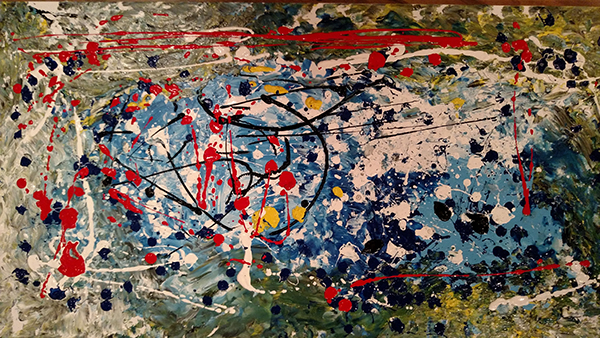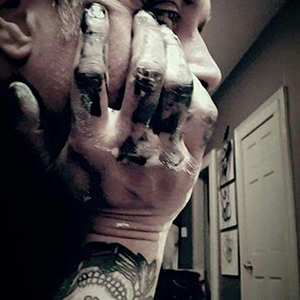
Untitled, oil or acrylic on canvas. © 2015 Jason Richard
“The intuitive mind is a sacred gift and the rational mind a faithful servant. We have created a society that honors the servant and has forgotten the gift.” – Albert Einstein
How creative are you? What types of creative activities do you regularly pursue? When you run a busy law practice and an even busier life, carving out time for creative pursuits may seem impossible, but we are all, in some way, wired to create.
Let me introduce you to Jason Richard, a personal-injury attorney who has been practicing in the Milwaukee area since 2001.1 In addition to practicing law full time, Jason is an artist, focusing on acrylic, acrylic lithograph, and oil abstract portraiture. We recently had a chance to talk about his creative pursuits, and it was clear how much his creativity positively affects both his law practice and his home life.
 Paula Davis-Laack, Marquette 2002, MAPP, is the founder of the Stress & Resilience Institute, a training and consulting firm focused on enhancing resilience, well-being, and engagement in the legal profession. She is the author of the e-book, Addicted to Busy: Your Blueprint for Burnout Prevention. Portions of this article previously appeared on Forbes.com.
Paula Davis-Laack, Marquette 2002, MAPP, is the founder of the Stress & Resilience Institute, a training and consulting firm focused on enhancing resilience, well-being, and engagement in the legal profession. She is the author of the e-book, Addicted to Busy: Your Blueprint for Burnout Prevention. Portions of this article previously appeared on Forbes.com.
In childhood, he started drawing, a hobby that he actually stopped pursuing when he first began practicing law. As his law career progressed, he reconnected with his artwork as a way to destress. He said that, “When I paint, I have the freedom to decide what to put on the canvas. There are no deadlines, and it helps me think about something other than the law for a while.”
In addition, he has discovered that his passion for art has expanded his relationships. He says, “my kids love supporting dad at gallery showings,” and he finds that it’s a point of interesting conversation for his clients. According to Jason, “My clients find it interesting, and more of my clients are getting into art, so it’s common ground and an interest we immediately share.”
Jason has simple advice for attorneys and it applies at all stages of their careers: “It’s so important to disconnect and have a separate outlet from your law practice, whether it’s working out or another type of hobby.”
Unlike Jason, I was convinced early in life that I was born without the creativity gene. I hated drawing in art class, and I have never been the arts and crafts type. Luckily, creativity comes in all forms and can really be part of any larger hobby you decide to pursue, whether it is writing, dancing, or baking – you just need to connect to the ingredients that help nurture and grow creativity.
What Creative People Do Differently
In their new book, Wired to Create, Scott Barry Kaufman and Carolyn Gregoire offer up 10 things highly creative people do differently.2 According to the authors, highly creative people:
- Engage in imaginative play;
- Are passionate about something;
- Daydream;
- Spend time in solitude;
- Are intuitive;
- Are open to experience;
- Are mindful;
- Show sensitivity;
- Turn adversity into advantage; and
- Think differently.
According to Kaufman and Gregoire, “Creative people are the hubs of diverse interests, influences, behaviors, qualities, and ideas – and through their work, they find a way to bring these many disparate elements together.”3
The problem is that the pace of contemporary society can make it hard to make time for a number of the creativity building blocks on this list. When was the last time you daydreamed (only if you can daydream in billable increments!)? Do you ever carve out 5 or 10 minutes in your day to just sit and think, by yourself and without distractions?
If you find yourself constantly distracted by the busyness of your law practice, try the STOP mindfulness technique to help you pause in the moment. Here are the steps:
S: Stop. Literally, stop what you are doing and pay attention to how you’re feeling and what you’re thinking.
T: Take a breath. Taking a quick breath or two helps you to re-center and refocus.
O: Observe. Make a mental note of where you feel tension in your muscles. Are your shoulders tight? Is your jaw clenched? What are you thinking, and are those thoughts productive or counterproductive?
P: Proceed. Now that you have a little additional information about the sources of stress in your environment, proceed with what you were doing. The goal is to go about your merry way, but in a more intentional and balanced way.4
Whether you want to try and incorporate more of these creativity elements or just want to relax for a few minutes during your day, STOP is a good place to start.
10 Things Highly Creative People Do Differently
- Engage in imaginative play;
- Are passionate about something;
- Daydream;
- Spend time in solitude;
- Are intuitive;
- Are open to experience;
- Are mindful;
- Show sensitivity;
- Turn adversity into advantage; and
- Think differently.
STOP Mindfulness Technique to Pause in the Moment
If you find yourself constantly distracted by the busyness of your law practice, try the STOP mindfulness technique to help you pause in the moment.
S: Stop. Literally, stop what you are doing and pay attention to how you’re feeling and what you’re thinking.
T: Take a breath. Taking a quick breath or two helps you to re-center and refocus.
O: Observe. Make a mental note of where you feel tension in your muscles. Are your shoulders tight? Is your jaw clenched? What are you thinking, and are those thoughts productive or counterproductive?
P: Proceed. Now that you have a little additional information about the sources of stress in your environment, proceed with what you were doing. The goal is to go about your merry way, but in a more intentional and balanced way.
Creativity, Resilience, and Burnout
Resilience is an important component of creativity. In fact, Kaufman states that “resilience is practically a prerequisite for creative success.”5 Doing creative work often involves rejection and failure, and successful creative individuals learn not to take failure so personally. Creativity can also be a positive coping mechanism during challenge and adversity. Jason Richard described how painting has helped him manage significant personal and professional challenges, providing a source of mental and physical calm.
There are only a few studies exploring the connection between creativity and burnout, and the results are mixed. One study found that people who are experiencing burnout are less creative (and those who were not burned out were more creative),6 while other studies have found a connection only between creativity and the personal accomplishment dimension of burnout (meaning that those professionals who felt a higher sense of personal accomplishment and efficacy were more creative).7
The creative mind is messy and complex. It’s also a source of stress relief for lawyers. You don’t need to be the next Picasso or Hemingway to start becoming more creative in your life. I’d love to hear about the strategies you try. Post a comment to this article or email the editors at wislawyer@wisbar.org.
Jason Richard In His Own Words

I use a variety of mediums for my art. Pencil, ink, water colors, but mostly oil or acrylics on canvas. The choice of medium depends on my patience level.
I rarely name my artwork. I leave that to the owner because, as a collector of art, I feel the purchasing of art can be even more personal than the creating. Art is a very fluid concept, and I don’t typically start to gather direction on a piece until I’m well into it. I use what emotions I’ve been experiencing, the emotions of friends and family, and start from there. The work can be fueled by anger, joy, a sense of peace, and so on.
I like to use the art of others as inspiration for many of my pieces. One of my favorite quotes is Picasso’s, “good artists copy, great artists steal.” Much of my work steals bit and pieces from things in everyday life I feel moved by and hope to incorporate into the work.
The process of creating is more important to me than the end result, because it really is a diversion from the everyday rigors of life. It’s an escape, a release, a chance to be in my own head while not solving the problems of others.
Endnotes
1 Interview with Jason S. Richard, Esq., on Feb. 15, 2016.
2 Scott Barry Kaufman & Carolyn Gregoire, Wired to Create: Unraveling the Mysteries of the Creative Mind (New York, NY: Perigee 2015).
3 Id. at xx.
4 Bob Stahl & Elisha Goldstein, A Mindfulness-Based Stress Reduction Workbook 60-61 (Oakland, CA: New Harbinger Publications Inc. 2010).
5 Carolyn Gregoire, 18 Things Highly Creative People Do Differently (March 4, 2014), Huffington Post, www.huffingtonpost.com/2014/03/04/creativity-habits_n_4859769.html.
6 Czeslaw Noworol et al., “Impact of Professional Burnout on Creativity and Innovation” in Professional Burnout: Recent Developments in Theory and Research 163-75 (Wilmar B. Schaufeli, Christina Maslach & Tadeusz Marek, eds.) (Philadelphia, PA: Taylor and Francis (1993)).
7 Behzad Ghonsooly & Ali Raeesi, “Exploring the Relationship between Creativity and Burnout among Iranian EFL Teachers,” 4(3) Int’l J. of Linguistics, 121-34 (2012).
